Keeping your plumbing pipes from freezing during the winter can seem like an impossible task in some of the coldest areas of the country. Needless to say, there are a few steps you can take to winterize your bathroom to make sure that your plumbing doesn’t freeze up.
To do this, you want to make sure that your home is well insulated. For pipes that are running through the attic, you want to make sure that your pipes are running underneath the insulation so that they stay warm. Here are some more tricks to keep your water pipes from freezing. But first.
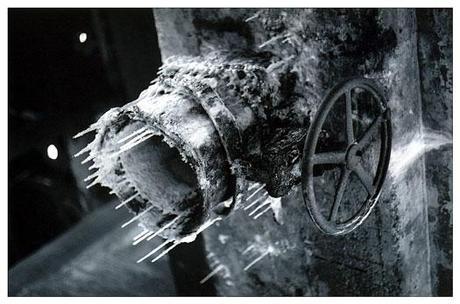
Photography by Goran Zec
What Can Happen if Your Pipes Freeze?
- Frozen pipes not only mean that you no longer have access to water but it could actually crack your toilet and cause serious flooding inside your home.
- Frozen pipes can cause your pipes to burst because of the pressure the expansion places on the pipes. This will most likely happen around joints but it can create cracks anywhere in the pipe.
How to Tell if Your Pipes are Frozen
- The visual signs include swollen pipes that are bulging at a certain point.
- When your toilet tank doesn’t refill after a flush.
- When water does not come out of your faucet fixtures when you turn the water on.
How to Prevent Water Pipes from Freezing
1. Electric Pipe Wrap
One of the first things you should do is wrap your plumbing pipes to insulate the pipes from freezing temperatures. You can purchase an electric heat cable kit from Home Depot. All you have to do is tape the electric heat cable to the underside of your pipes with electrical tape. The cable then plugs into a standard electrical outlet to send heat directly to your water pipes. It’s very inexpensive and can be done on your own if you have access to your plumbing pipes. For extra protection, you can then wrap your electric heat cable kit with heat insulation to prevent heat from dissipating.
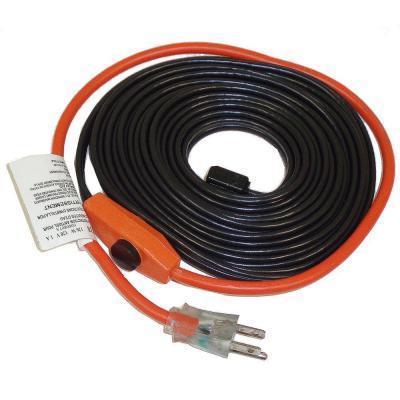
The Frost King Electric Heat Cable Kit from Home Depot. Just tape this to your plumbing pipes and plug it into an outlet.
2. Leave Doors Open
Keep your bathroom doors open so that warm air within the house can travel into the bathroom. You don’t want to separate the bathroom into a freezing ice box within your home.
You should also leave the doors on your vanity open so that warm air is able to reach the plumbing pipes beneath your wash basin. If the pipes under your sink freeze, they could crack your sink and cause leakage. This often leads to a waterlogged cabinet bottom.
3. Seal Your Bathroom Windows
During winter, the cold is your worst enemy. To keep the bone-chilling weather from affecting your bathroom plumbing, make sure that all of your windows are properly sealed. You don’t want any leaks around the window that will allow warm air to escape. You can install double paned glass windows that aide in thermostatic temperature stabilization. Learn how to check for window insulation leaks here.
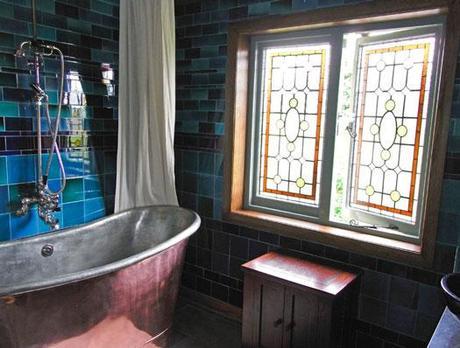
Photography by Charlotte Holmes.
4. Set up an Electric Heater in Your Bathroom
Set up an electric heater in your bathroom to keep the temperature at a constant state. It doesn’t have to be comfortable for guests, just warm enough that your pipes aren’t freezing and your electric bill doesn’t spike as a result of your bathroom heater. You can find a nice heater for your bathroom at sites like PortableFireplace.com.
5. Insulation
Insulation keeps your home warm and if you have thin or low-grade insulation between your walls, your home could be losing heat faster than it should be. This is a larger job that requires the walls in your home to be opened up, but it is something to consider if you’re undergoing a bathroom or home remodeling project. Remember that insulation does not provide heat, all it does is slow down the transfer of heat.
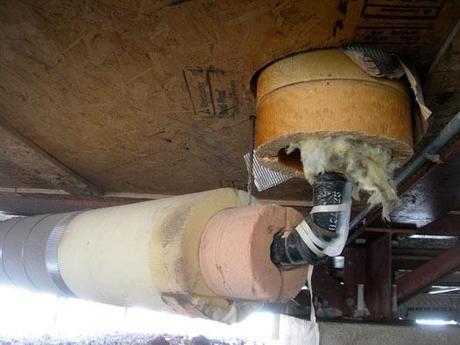
Wrapping your plumbing pipes with insulation will help keep them from freezing. Photography by Eli Duke.
How to Winterize Your Toilet
Once the temperature reaches below 32 degrees Fahrenheit (freezing point), you have to worry about your toilet freezing up, cracking, and flooding your home’s interior. Toilets are made of ceramic materials which are the same thing as a coffee mug. When they expand too much, they will crack and allow water to flow into your beautiful bathroom.
Plumbers Anti-Freeze
Anti-freeze is the same thing that you put in your cars to prevent your cars radiator. As the name implies, anti-freeze will help prevent your water from freezing. Always use non-toxic anti-freeze that is made for plumbing systems. You don’t want to use the same anti-freeze that you use in your car. Automotive antifreeze uses Ethylene Glycol which is not okay for home sewage systems. Propylene Glycol is used in Recreational Vehicles (RVs) and is okay to use in your home water system. This is typically advertised as RV Antifreeze.
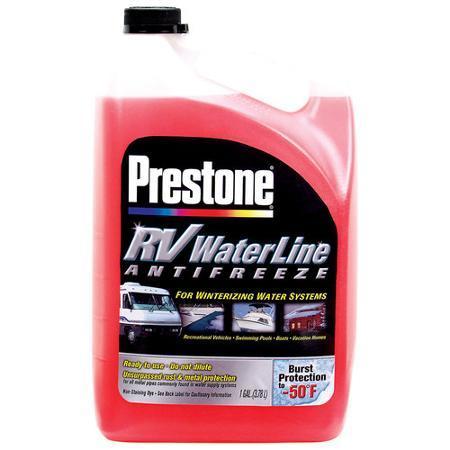
Preston RV Waterline Antifreeze is safe to use inside the home.
You can pour anti-freeze directly into the water tank of your toilet once you’ve drained the water out of the tank. You can do this by holding the flush lever down until the tank is empty and then turning off your shut off valve behind the toilet. Remember to use safety goggles when pouring in these ingredients.
Once you’ve emptied your bottle of plumbing anti-freeze, flush the anti-freeze by holding down on your toilet lever until the tank is emptied completely.
Bonus Tip: Bathtubs and shower drains can also freeze. Pour anti-freeze down your shower drain to prevent these pipes from freezing as well.
Do I Have to Get a New Toilet?
Some people will tell you that you need to replace your toilet if your pipes freeze but this isn’t necessary in all cases. Depending on how bad your toilet froze, your toilet may or may not need to be replaced.
For temperatures down to 10 degrees, you should be alright but once you drop down to -10 degrees, then you will need to consider replacing your toilet. What happens is that the frozen ice gets so cold that it cracks your ceramic/porcelain toilet. It’s similar to what would happen if you place a soda can or a glass bottle filled with liquid in the freezer.
You can tell if your toilet needs to be replaced by looking for water leaks after all of the ice has melted. Check around the base of the toilet to look for any signs of water draining; this will indicate that your toilet has been cracked and needs to be replaced.
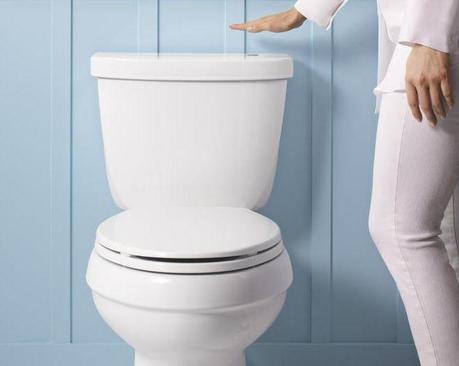
Kohler makes an all new Touchless Toilet that flushes with the wave of a hand.
Find a replacement toilet.
What to Do When Your Water Pipes Freeze
Having your pipes freeze can seem like the end of the world but there are things you can do to thaw out your plumbing pipes during the winter.
- The other make shift method is to grab a blow dryer and use it to heat your frozen pipes. This is obviously not a scientific method but hey, it works. Desperate times call for desperate measures.
- If you have radiant flooring, you can turn up the heat to help thaw out toilet pipes that run beneath the ground.
Be careful when thawing out your pipes because water can begin to leak while you are thawing out the pipes. The frozen ice may be what’s preventing water from leaking through but once thawed, this water may leak through these holes and cracks so be sure your monitor your pipes during the thawing process. It’s advisable to shut off your water supply when thawing out plumbing pipes.
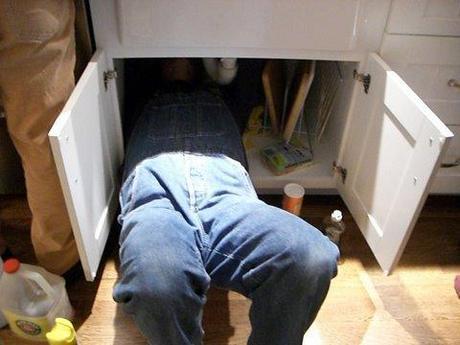
Last but not least, you can always contact a plumber to thaw out your pipes. Learn how to hire a good plumber. Image via flickr
Conclusion
Whether you live in the ice cold Rockies or the frigid mid-west, frozen pipes are a real headache for many homeowners. By preparing ahead of time you can make sure that your pipes don’t freeze this winter. Below are a list of additional resources for your plumbing questions.
Visit TradeWindsImports.com for all of your water damage replacement needs.
Related Topics:
- The Answer to All of Your Basic Plumbing Questions
- Troubleshooting Gurgling Drains
- The NAHB Releases Life Expectancy Data of Plumbing, Appliances, Furniture
- The Top 10 Strangest Toilet Clogs
About the Author
Cheryl Khan is a designer and writer at Tradewinds Imports.com, an online specialty site dedicated to retailing fine bathroom furnishings. She has extensive knowledge about all the finer details that go into planning the perfect bath renovation project and is an expert on all things bathroom! Send her your bathroom Q’s on twitter @SuperInteriors!
